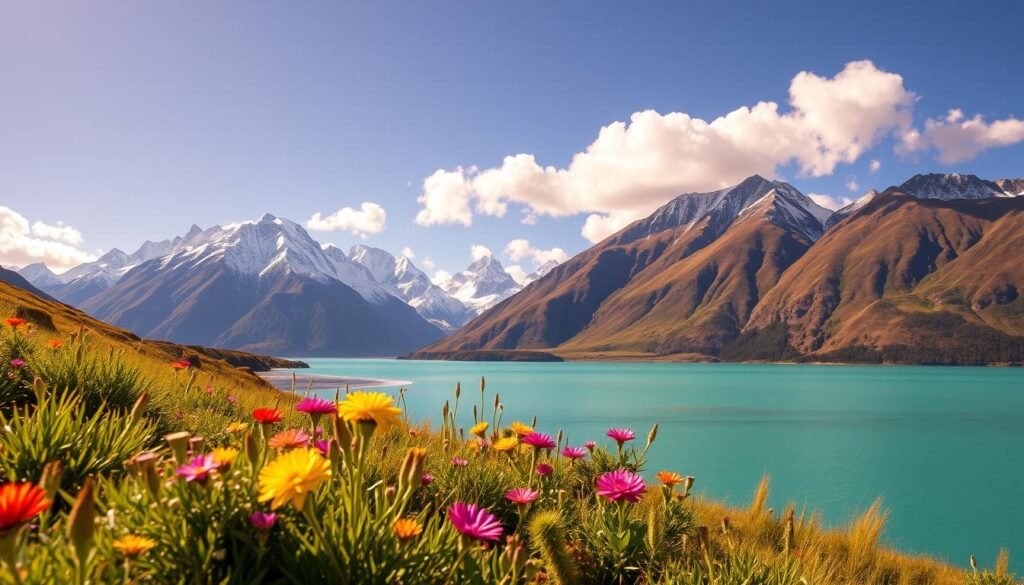Surprising fact: summer brings long, bright days with highs around 68–77°F and sea temps near 68°F, and February is usually the hottest month.
I write from experience: late December sees locals head for the beach and many businesses close. I recommend planning around the holiday rush if you want lower crowds and easier bookings.
For my money, late January to early March is the sweet spot. Most Kiwis are back at work, the weather often settles, and you can catch more sunny days for beaches and hikes without peak prices.
Keep in mind the weather can flip fast. I’ve seen alpine snow and -7°C wind chill on high passes in December, so I pack layers and flexible plans year-round.
I’ll compare islands, outline month-by-month highlights, and map when to book huts, cars, and activities for better trips through this country.
Key Takeaways
- Summer offers long days and warm seas but brings the biggest crowds.
- Late January to early March often balances warm weather and lower demand.
- Weather is famously changeable—pack layers and a rain shell.
- North and South islands show different seasonal patterns worth planning for.
- School holidays and ski season drive prices and availability.
Best time to visit New Zealand: My quick verdict (and how I decide)
Quick verdict: aim for late January through March if you want classic beach weather and more availability. February often brings the driest, warmest stretch, and March usually keeps warm days with thinning crowds.
I weigh three things: likely weather, daylight hours, and school holidays. Long summer days mean more hiking and relaxed driving. Short winter days push me toward cities, hot springs, and ski fields.
I also factor festivals and booking windows. New Year’s events and big March festivals lift demand, so I avoid late December–mid-January unless I lock accommodation months ahead.
If alpine clarity matters, I aim for late summer into early autumn for better odds of stable windows. For ski or dark-sky trips I plan winter and add buffers for storms and inter-island flights.
- I book Great Walks early (DOC opens bookings in May).
- I keep a Plan B list: hot springs, museums, and wineries for rainy days.
- Decide your priority—beaches, hikes, snow, or festivals—and match months to those goals.
Seasons at a glance: Summer, shoulder seasons, and winter
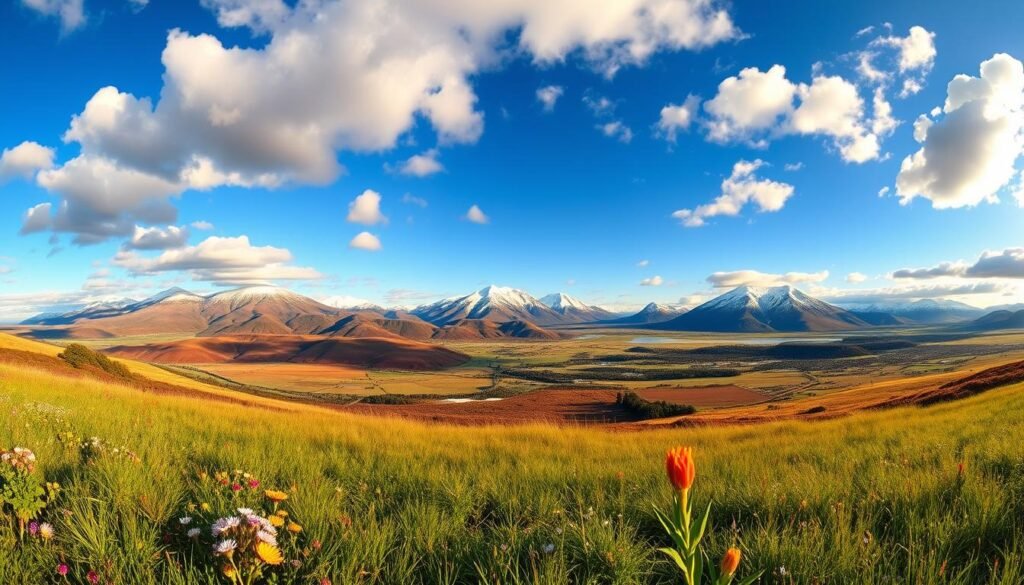
I map the year by how days, crowds, and weather shift across the islands. That helps me pick which months fit my plans and when to book flights, huts, and cars.
Summer (December–February)
Long days, warm seas, and mild temperatures (about 68–77°F / 20–25°C) make this the beach and hiking prime. February is usually the hottest and driest, but late December–early January brings peak pricing and crowds.You can learn more about best-time-to-visit-hawaii
Autumn shoulder season (March–May)
This is my favorite for settled weather and thinner crowds. North Island waters often stay warm, and autumn color peaks around Arrowtown and Cromwell.
Winter (June–August)
Quiet coastal towns and big snow in alpine zones define winter. Queenstown, Wānaka, and Mt Hutt buzz for skiing, while some operators pause for the season. Roads can be icy—plan for chains.
Spring shoulder season (September–November)
Spring brings changeable skies, blooming gardens, and Great Walks reopening from late October. October–November is ideal for mountain biking and winery visits if you dress for showers.
| Season | Key perks | Watch outs | Top picks |
|---|---|---|---|
| Summer | Long days, warm seas, festivals | High prices, crowds (Dec–Jan) | Beaches, hiking, lupin displays |
| Autumn | Settled weather, fall color | Fading daylight | Scenic drives, clearer hikes |
| Winter | Snow sports, quieter coasts | Icy roads, closed services | Ski fields, city festivals |
| Spring | Blooming landscapes, Great Walks reopen | Changeable weather | Mountain biking, wineries |
North Island vs South Island: What changes with the time of year
Seasons shape what you can do and where you’ll go on each island. I split planning by climate and by what I want from my days—beaches, city culture, or alpine drama.
North Island: beaches, hot springs, and city culture
The north island gives warm summer swims around Bay of Islands and Mt Maunganui, so I book accommodation early for those places.You can learn more about best-time-to-visit-vietnam
Winters are milder but wetter. That’s when I head for Rotorua hot pools or Auckland’s food festivals on rainy days.
South Island: mountains, snow, and clear nights
The south island is my pick for alpine hiking in summer and skiing from June through early October. Snow and icy roads need careful driving, especially around Queenstown and Canterbury.
I also chase stargazing in Mackenzie Country on crisp clear nights.
“I often spend wet north days in cities, then jump south for blue-sky mountain windows.”
| Island | Seasonal perks | Plan notes |
|---|---|---|
| North Island | Beaches, hot springs, mid-winter festivals | Book coastal stays early; pack rain gear |
| South Island | Skiing, alpine hikes, dark skies | Carry chains in winter; expect higher accommodation costs in ski towns |
Month-by-month guide: What to expect from January to December
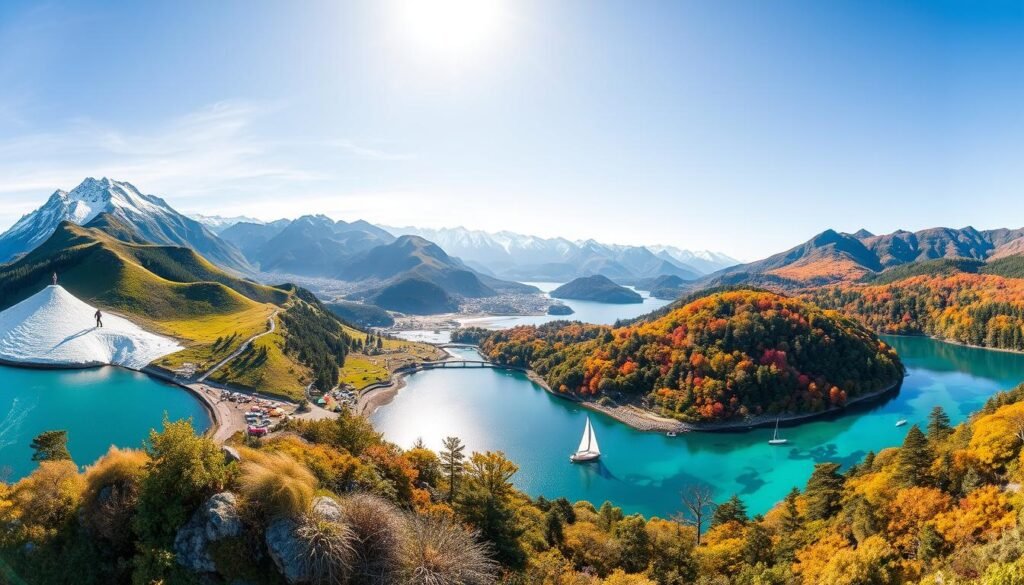
To help you choose, I run through January to December with what usually works and what to watch. Short notes below flag temperatures, crowd patterns, and key activities so you can plan clear days and bookings.
January
Classic beach days and snorkeling. High temps near 77°F and heavy crowds; many city businesses close.You can learn more about best-islands-to-visit
February
Hottest, drier month—great for hikes, boat trips, and mountain biking once school holidays fade.
March
Settled weather, 65°F+ days, and big festivals like WOMAD and Pasifika.
April
Autumn color and crisp hikes; watch Easter and school holiday pinch points.
May
Low-season bargains, quieter Hobbiton visits, and early mountain snow possible.
June
Matariki events and ski fields opening; South Island mornings can dip to near 28°F by Lake Tekapo.
July
Mid-winter volatility—hot springs and indoor city events are dependable backups.
August
Peak snow for skiing and heli-hiking; icy roads mean chains and checks before alpine drives.
September
Spring blooms, quieter trails, and Hobbit Day festivities.
October
Spring shoulder months suit national park walks and sailing on Lake Taupō; Great Walk permits open late October.
November
Longer days, wineries, glowworms, and marine wildlife viewing around Kaikōura.
December
Summer starts, lupins near Lake Tekapo, rising accommodation demand as school holidays and New Year approach.
The best time to visit New Zealand for specific activities
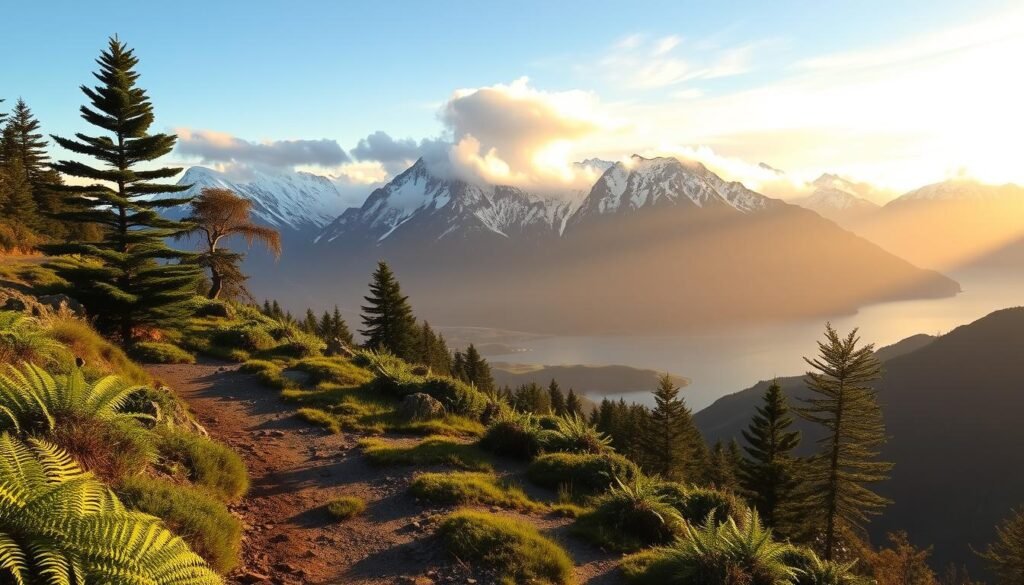
I plan activities around what each season unlocks. For long multi-day hiking and Great Walks, I aim for late October through April. That window gives longer daylight and safer higher passes. I book DOC huts as soon as reservations open in May for Milford, Routeburn, and Kepler—spaces fill fast.
Skiing and snow: most fields run June through early October. I target July–August for the deepest snow and split ski days between Queenstown/Wānaka and Mt Hutt when conditions allow. In winter I avoid avalanche terrain unless I have training and proper kit.
Wildflower seekers will love lupins in December–February around Lake Tekapo and the Mackenzie. On North Island coasts, pōhutukawa blaze red in summer and make for great shore walks and photos.
Stargazing shines in clear, long winter nights. I book nights in the Aoraki Mackenzie Dark Sky Reserve or Aotea/Great Barrier Island, pair them with hot pools, and hope for low humidity and crisp air.
- I block late October–April for big alpine hiking and Great Walks.
- I plan ski trips June–early October, centering July–August if I want deep snow.
- I check temperatures and pack layers, microspikes, and a rain shell for alpine days.
“I keep buffers for heli-hiking and swap to wineries or hot springs if flights are grounded.”
Crowds, prices, and school holidays: How timing affects your budget
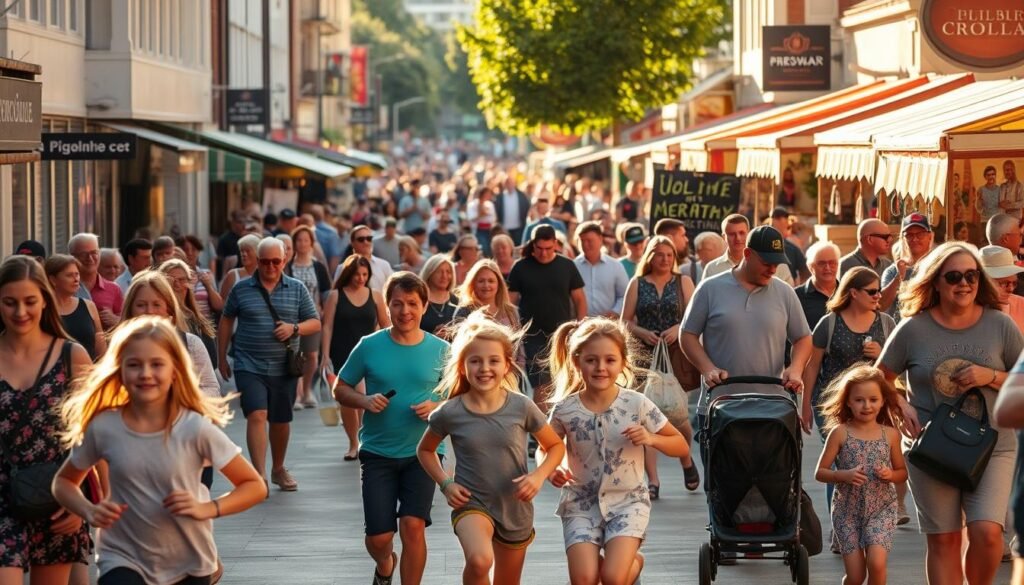
When I plan trips here I start with the calendar. School holidays and festival weekends drive the biggest spikes in accommodation and car rental costs.
Peak season — late December–mid January & February hotspots
Expect higher prices and sold-out stays. I book months ahead for summer coastal towns and Great Walks. February eases after the school holidays but still fills hot spots.
Shoulder seasons — March–May & September–November
These windows often give the best mix of weather and value. I find thinner crowds, lower rates, and more flexible days for driving and hiking.
Low season — June–August
Prices fall across most places, though ski towns spike. I watch Australian and Kiwi school holidays in July when winter demand rises.
Public holidays and Matariki
Matariki, Easter, and festival weekends can quietly sell out tours and rooms. I lock big-ticket dates early and keep cancellation-friendly rates for flexibility.
- I often split stays to cheaper nearby towns to save on peak days.
- I plan driving days mid-week and budget for rainy-day activities so booked days aren’t wasted.
- For detailed booking windows I consult a trip guide like best time to visit guide.
| Season | Price signal | Booking tip |
|---|---|---|
| Peak | High | Book 3+ months ahead |
| Shoulder | Moderate | Book 4–8 weeks ahead |
| Low | Low (except ski towns) | Look for deals; watch holiday weekends |
Weather reality: Packing and safety for a country of four seasons in a day
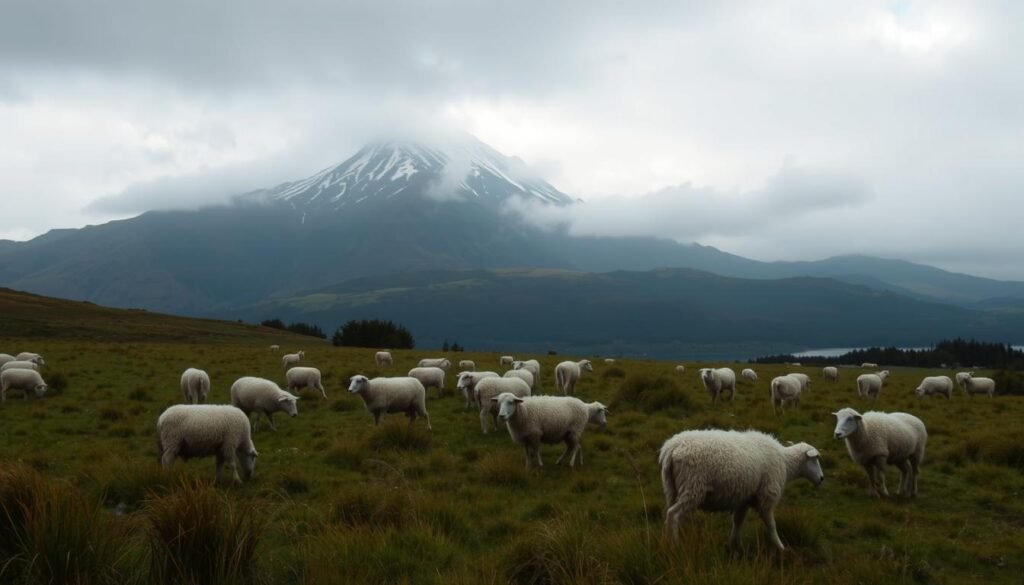
Weather here flips fast; a sunny morning can end with sleet on a ridge by noon. I plan each day knowing that regional temperatures and conditions vary across areas, and I check forecasts before I go.
What I pack year‑round
I always carry a breathable rain shell, an insulating mid‑layer, and a compact puffer—even in summer. I add sun protection and merino baselayers for cooler spells.
Tip: a dry bag protects maps and electronics, and a small headlamp saves late days when light fades.
For a full checklist I link to my packing guide here: New Zealand packing list.
Driving and alpine safety
In winter months I carry snow chains and avoid dawn drives on frosty roads. South Island passes can require chains, and some alpine routes close when snow or avalanche risk rises.
I check MetService and DOC advisories and reroute to a coastal national park walk when mountain tracks are unsafe.
Plan B days I love
If the weather shuts an area down, I choose hot springs, vineyards, or festivals instead. Maruia Hot Springs, Rotorua’s Kerosene Creek, and Ngawha Springs are reliable backups.
“Flexibility is my best travel tool; a detour often becomes the highlight of the trip.”
How I plan my New Zealand trips by season and region
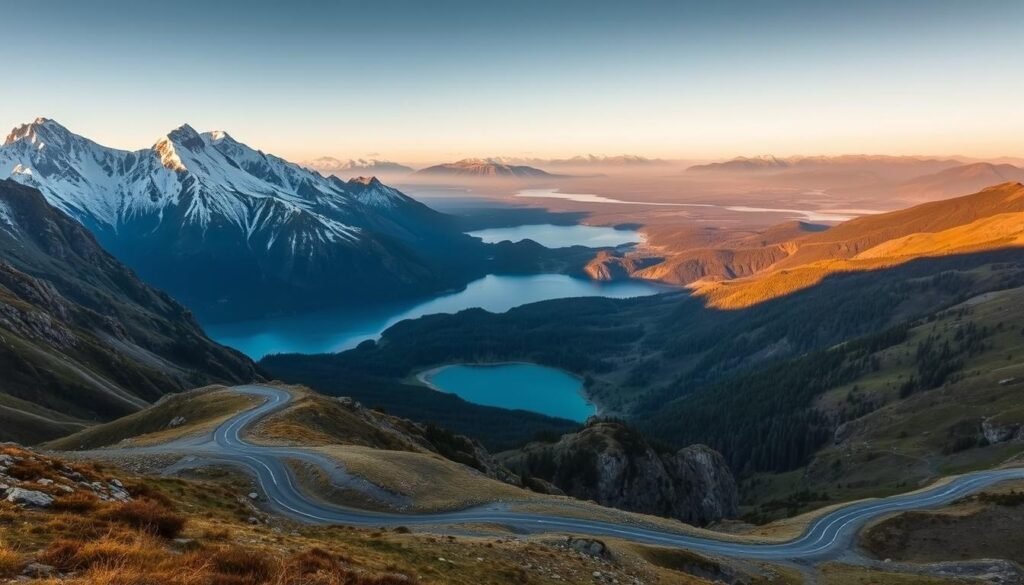
My trip itineraries start by matching season, region, and the handful of activities I refuse to miss. That gives me a clear framework to book key nights, keep flexibility, and choose places that work if the weather shifts.
Summer strategies
Book early and base by the coast. For new zealand summer I reserve coastal bases months ahead — Bay of Islands, Mt Maunganui, Abel Tasman — then plan sunrise hikes and golden-hour swims to dodge midday crowds.
Autumn game plan
I route the south island into color loops through Arrowtown and Cromwell. March–April often offer settled days, so I stack clear-weather hikes with orchard stops for apples and stonefruit.
Winter approach
In winter I split a week between Queenstown/Wānaka ski days and city culture in Wellington or Auckland. If the forecast is clear I tack on a Mackenzie dark-sky night for stargazing.
Spring playbook
Spring means Great Walks reopen late October. I lock hut or permit dates early, hunt shoulder pricing on lodging and cars, and pencil in mountain biking days near Queenstown/Wānaka in October–November.
Practical rules I always follow:
- I track weather systems and shift must-do hikes to the best window, swapping in vineyards or hot pools when fronts arrive.
- I choose places with dual personalities — Queenstown is adrenaline on blue days and great dining on wet ones.
- I spread driving across the trip, leave white space for detours, and hold refundable bookings for key activities.
- For planning tips and booking windows I often consult a regional trip guide like how to plan a New Zealand.
“Flexibility and a few refundable bookings let me dance around weather without losing the spirit of the trip.”
Conclusion
There isn’t one single perfect month; there’s your perfect fit. I pick months by the activities I want and how much flexibility I can hold.
If you want settled warm days and long light, aim late January–March. For value and autumn color, March–May shines. If powder and starry nights draw you, plan around June–August.
Spring shoulder windows (late October–November) open Great Walks and sweet mountain biking. Book for school holidays, ski towns in July, DOC huts, and big festivals well ahead.
Pack layers, leave buffer days for heli trips or alpine crossings, and carry chains in winter. Do that and you’ll almost always have a great time in this country.
Places that sing by season: Lake Tekapo’s dark sky, Queenstown’s winter buzz, Bay of Islands for summer swims. With a flexible plan, you’ll have a good time—and often a truly great time.


